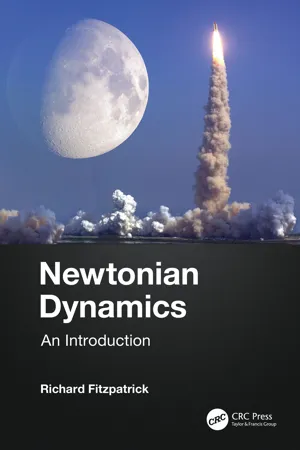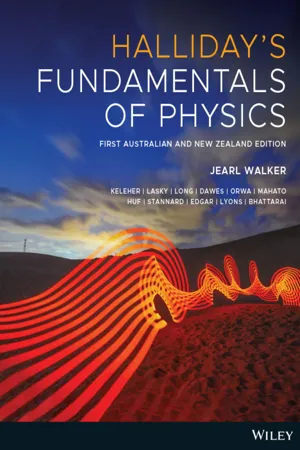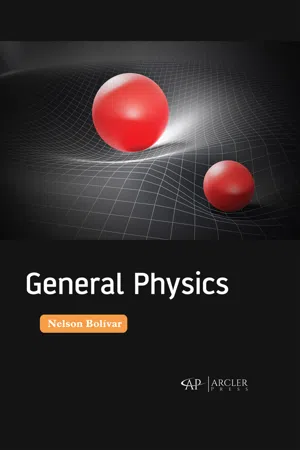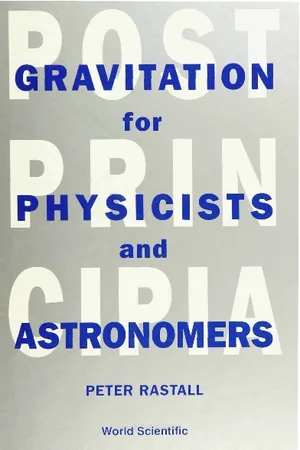Physics
Gravitational Potential Energy
Gravitational potential energy is the energy stored in an object due to its position in a gravitational field. It is directly proportional to the object's mass, the acceleration due to gravity, and its height above a reference point. This energy can be converted into kinetic energy as the object falls, demonstrating the relationship between potential and kinetic energy in physics.
Written by Perlego with AI-assistance
Related key terms
1 of 5
8 Key excerpts on "Gravitational Potential Energy"
- eBook - ePub
Newtonian Dynamics
An Introduction
- Richard Fitzpatrick(Author)
- 2021(Publication Date)
- CRC Press(Publisher)
The mass falls because it is subject to a downward gravitational force of magnitude m g. It stands to reason, therefore, that the transformation of kinetic into potential energy is a direct consequence of the action of this force. This is, perhaps, an appropriate point at which to note that the concept of Gravitational Potential Energy—although extremely useful—is, strictly speaking, fictitious. To be more exact, the potential energy of a body is not an intrinsic property of that body (unlike its kinetic energy). In fact, the Gravitational Potential Energy of a given body is stored in the gravitational field that surrounds it. Thus, when the body rises, and its potential energy consequently increases by an amount Δ U, in reality, it is the energy of the gravitational field surrounding the body that increases by this amount. Of course, the increase in energy of the gravitational field is offset by a corresponding decrease in the body’s kinetic energy. Thus, when we speak of a body’s kinetic energy being transformed into potential energy, we are really talking about a flow of energy from the body to the surrounding gravitational field. This energy flow is mediated by the gravitational force exerted by the field on the body in question. Incidentally, according to Einstein’s general theory of relativity (1915), the gravitational field of a mass consists of the local distortion that the mass induces in the fabric of space-time. Fortunately, however, we do not need to understand general relativity in order to talk about gravitational fields or Gravitational Potential Energy. All we need to know is that a gravitational field stores energy without loss; that is, if a given mass rises a certain distance, and, thereby, gives up a certain amount of energy to the surrounding gravitational field, then that field will return this energy to the mass without loss if the mass falls by the same distance - David Halliday, Jearl Walker, Patrick Keleher, Paul Lasky, John Long, Judith Dawes, Julius Orwa, Ajay Mahato, Peter Huf, Warren Stannard, Amanda Edgar, Liam Lyons, Dipesh Bhattarai(Authors)
- 2020(Publication Date)
- Wiley(Publisher)
• If the reference point of the particle is set as y i = 0 and the corresponding Gravitational Potential Energy of the system is set as U i = 0, then the Gravitational Potential Energy U when the particle is at any height y is U (y) = mgy. • Elastic potential energy is the energy associated with the state of compression or extension of an elastic object. For a spring that exerts a spring force F = −kx when its free end has displacement x, the elastic potential energy is U (x) = 1 2 kx 2 . • The reference configuration has the spring at its relaxed length, at which x = 0 and U = 0. Why study physics? Whether climbing the 134-metre-high top arch of Sydney Harbour Bridge or enjoying the 43-metre adrenaline-fuelled bungy jump at Kawarau Gorge Suspension Bridge in Queenstown, you are experiencing a change in your potential energy and conservation of energy. 1 Work and potential energy FIGURE 8.1 A tomato is thrown upward. As it rises, the gravitational force does negative work on it, decreasing its kinetic energy. As the tomato descends, the gravitational force does positive work on it, increasing its kinetic energy. Negative work done by the gravitational force Positive work done by the gravitational force In chapter 7 we discussed the relation between work and a change in kinetic energy. Here we discuss the relation between work and a change in potential energy. Let us throw a tomato upward. We already know that as the tomato rises, the work W g done on the tomato by the gravitational force is negative because the force transfers energy from the kinetic energy of the tomato (figure 8.1). We can now finish the story by saying that this energy is transferred by the gravitational force to the Gravitational Potential Energy of the tomato–Earth system. The tomato slows, stops, and then begins to fall back down because of the gravitational force.- eBook - PDF
- Nelson Bolívar(Author)
- 2020(Publication Date)
- Arcler Press(Publisher)
General Physics 122 Ug = Fg ⋅ h = m ⋅ g ⋅ h Figure 5.4. A weight lifted vertically to acquire Gravitational Potential Energy. Source: https://www.tes.com/lessons/PQ4Nky_diwdIrA/potential-and-kinetic-energy. The object would fall back down to the ground if the force was to be removed and the Gravitational Potential Energy would be changed into kinetic energy of the falling object. Our artifact on conservation of energy contains some example problems that are solved over knowledge of how Gravitational Potential Energy is transformed into other forms (Manga and Kirchner, 2004; McKenzie and Jackson, 2012). What is exciting about Gravitational Potential Energy is that we can choose the zero arbitrarily. In other words, we have the freedom to select any vertical level as the location where h = 0. For simple mechanics problems, a suitable zero point would be at the surface of a table or on the floor of the laboratory. In principle nevertheless, we could select any orientation point— sometimes called a datum . If the object were to pass below the zero points, the Gravitational Potential Energy could even be negative. This doesn’t present a problem, however; we just have to be certain that the same zero points are used constantly in the calculation (Flesch et al., 2007; Schmalholz et al., 2014). Work, Energy, and Power 123 Exercise 5.2: How much electrical energy would be used by an elevator lifting a 75 kg person through a height of 50 m if the elevator system has an overall efficiency of 25%? Assume the mass of the empty elevator car is properly balanced by a counterweight (Figure 5.5). Figure 5.5. Schematic of an elevator system. Source: https://www.khanacademy.org/science/physics/work-and-energy/work-and-energy-tutorial/a/what-is-gravitational-potential-energy. Electrical energy through the grid is transferred into the Gravitational Potential Energy of the heat and person because of friction inside the elevator system. - eBook - PDF
- David Halliday, Robert Resnick, Jearl Walker(Authors)
- 2021(Publication Date)
- Wiley(Publisher)
(8.1.7) If the reference point of the particle is set as y i = 0 and the cor- responding Gravitational Potential Energy of the system is set as U i = 0, then the Gravitational Potential Energy U when the par- ticle is at any height y is U( y) = mgy. (8.1.9) Elastic Potential Energy Elastic potential energy is the energy associated with the state of compression or extension of an elastic object. For a spring that exerts a spring force F = −kx when its free end has displacement x, the elastic potential energy is U(x) = 1 _ 2 kx 2 . (8.1.11) Additional examples, video, and practice available at WileyPLUS 210 CHAPTER 8 POTENTIAL ENERGY AND CONSERVATION OF ENERGY is not involved, the work done on the system and the change ∆E mec in the mechanical energy of the system are equal: W = ∆E mec = ∆K + ∆U. (8.4.1, 8.4.2) When a kinetic frictional force acts within the system, then the thermal energy E th of the system changes. (This energy is asso- ciated with the random motion of atoms and molecules in the system.) The work done on the system is then W = ∆E mec + ∆E th . (8.4.9) The change ∆E th is related to the magnitude f k of the frictional force and the magnitude d of the displacement caused by the external force by ∆E th = f k d. (8.4.7) Conservation of Energy The total energy E of a system (the sum of its mechanical energy and its internal energies, including thermal energy) can change only by amounts of energy that are transferred to or from the system. This experimental fact is known as the law of conservation of energy. If work W is done on the system, then W = ∆E = ∆E mec + ∆E th + ∆E int . (8.5.1) If the system is isolated (W = 0), this gives ∆E mec + ∆E th + ∆E int = 0 (8.5.2) and E mec,2 = E mec,1 − ∆E th − ∆E int , (8.5.3) where the subscripts 1 and 2 refer to two different instants. Power The power due to a force is the rate at which that force transfers energy. - No longer available |Learn more
Physics for Scientists and Engineers
Foundations and Connections, Extended Version with Modern Physics
- Debora Katz(Author)
- 2016(Publication Date)
- Cengage Learning EMEA(Publisher)
UNIVERSAL Gravitational Potential Energy ▲ Special Case The subscript G is a reminder that Equation 8.7 is good for particles that interact through (universal) gravity. Plotting Universal Gravitational Potential Energy EXAMPLE 8.5 Plot U G 1r 2 versus r and show with a sketch how it connects to a spacecraft moving directly away from the Earth. Should the change in the system’s Gravitational Potential Energy be positive, negative, or zero? Does the graph give the predicted results for DU G ? INTERPRET and ANTICIPATE We put r on the horizontal axis and U G 1r 2 on the vertical axis (Fig. 8.14). It may be helpful to use a spreadsheet or similar program. Our sketch shows the Earth and the spacecraft at two different positions r u 1 and r u 2 . Because the spacecraft moves away from the Earth, we expect that the system’s Gravitational Potential Energy will increase: DU G . 0. SOLVE From the graph, U G 1r 2 2 . U G 1r 1 2 . Therefore the change in potential energy if the spacecraft moves away from the Earth from r u 1 to r u 2 is positive, which means that the Gravitational Potential Energy increases as the spacecraft moves away. DU G 5 U G 1r 2 2 2 U G 1r 1 2 U G 1r 2 2 . U G 1r 1 2 DU G . 0 CHECK and THINK The graph shows that as r S ` , the potential energy U G S 0 as required by our choice of the usual reference configuration. R { r 1 R { U G r 2 r r 2 u r 1 u FIGURE 8.14 8-5 Elastic Potential Energy The other conservative force we study in mechanics is exerted by a spring that obeys Hooke’s law. In this section, we derive an expression for the potential energy stored by such a spring, which is known as elastic potential energy. ELASTIC POTENTIAL ENERGY ▲ Special Case Figure 8.15 shows a block on a frictionless, horizontal surface attached to a spring. The other end of the spring is attached to a fixed wall. The system consists of the block, the spring, and the wall. For brevity, we omit the wall and refer to the system as a spring–block system. - eBook - PDF
Postprincipia: Gravitation For Physicists And Astronomers
Gravitation for Physicists and Astronomers
- Peter Rastall(Author)
- 1991(Publication Date)
- World Scientific(Publisher)
In other words, when r = 1 the kinetic energy contributes to the weight in the same way as the energy of a stationary particle. We emphasize that we are concerned with a system whose centre of mass is at rest in a static gravitational field. Putting r = —A = 1 in (3.3), we find that the passive gravitational energy in Newtonian units of the ■particles only is J/a = £ + £ m V h 2 = (£ + 3Bp). (3.4) b 4. Energy of the gravitational field The gravitational field is, so far, no more than a convenient device for calculating gravitational forces. We recall that the electric field played a similar role in elec-trostatics, but that it soon found other uses - first as a place to store the electric potential energy, and then in the description of electromagnetic waves. 3 A similar development in Newtonian gravity was halted when it was shown that the energy density of the gravitational field is negative. In a strictly static theory this would not matter, but as soon as there is any time dependence a system will presumably evolve to states of lower energy. Since there is no state of lowest energy - the gravitational energy can take arbitrary negative values - the system cannot attain equilibrium and singularities will develop. We must now see whether the same difficulty arises in gravitostatics. Let us first recall some earlier terminology and results. We have defined the gravitational field to be — V, where is the dimensionless potential. The gravitational force on a stationary particle of energy E is —EV(Z, .), where Z = (Z 1 , Z 2 , Z 3 ) are the coordinates of the particle in a ^> 0 frame. For a particle of velocity V = DZ, the gravitational force is -E[l+V 2 cJf 2 ]V(j>(Z, .), from 111(4.6) with V 2 = V 2 (we are using the standard values 111(3.6) of the parameters A, T, and n). When is static (d t ^> = 0) and only gravitational forces act on the particle, the quantity E = mc 2 N j is a constant of the motion. - eBook - PDF
- Richard C. Hill, Kirstie Plantenberg(Authors)
- 2013(Publication Date)
- SDC Publications(Publisher)
30 7.5.2) Gravitational Potential Energy................................................................................................. 30 7.5.3) Elastic potential energy .......................................................................................................... 33 7.6) WORK-ENERGY BALANCE & CONSERVATION OF ENERGY ................................. 36 7.6.1) The work-energy balance equation ........................................................................................ 36 7.6.2) Conservation of energy .......................................................................................................... 37 7.7) WORK-ENERGY FOR A SYSTEM OF PARTICLES .................................................... 44 7.7.1) Work ....................................................................................................................................... 45 7.7.2) Kinetic and potential energy ................................................................................................... 45 7.7.3) Work-energy balance ............................................................................................................. 46 7.8) POWER AND EFFICIENCY .......................................................................................... 51 7.8.1) Power ..................................................................................................................................... 51 7.8.2) Efficiency ................................................................................................................................ 53 CHAPTER 7 REVIEW PROBLEMS ..................................................................................... 56 CHAPTER 7 PROBLEMS .................................................................................................... 63 CHAPTER 7 COMPUTER PROBLEMS ............................................................................... - eBook - PDF
- Rodney Hill(Author)
- 2016(Publication Date)
- Pergamon(Publisher)
In fact, the accelerations of the mass-centres usually depend as well on the orientations and possible distortions of all bodies. ].14] GRAVITATIONAL POTENTIAL A N D POTENTIAL ENERGY 37 / / p a p = -grad^rf//, (3) alternatively to (6) in §1.13. The total potential φ is to be sharply distinguished from the total potential energy V (the clash in terminology being unfortunate, but firmly established). ^ is a function of the independent variable r as well as the entire mass-configuration, while V has to do only with the latter and is defined as an overall integral: pairs PQ | ( r p -r p ) + ( p -p ' ) φαμ (4) where <^ in a typical body Q is given by (2) with r = TQ + ρ'. The factor I is needed in the second expression for V since a typical inverse distance (say between αμ and αμ' in bodies Ρ and Q) appears twice: once in the integral over Ρ of the part of φ due to Q and again in the integral over Q of the part of φ due to P. For future reference we note, in passing, a variation formula: Σ ίδ (τ + ρ)αμ + δν = 0 (5) ν Ρ for arbitrary infinitesimal changes in the geometry (including shapes and orientations). This may be proved most conveniently by com-puting the variation of the integrand in the first expression for V, coupled with the observation that the range of integration over the mass distribution obviously does not alter even though the positions and shapes of material elements may do. With the special choice of variations such that the bodies are merely translated indepen-dently, without rotation or distortion, á (r + ρ) = δτρ throughout body Ρ for example and (5) becomes Σ(μαδτ)ρ + dV = 0 (6) with the help of (3) in §1.13. This generalizes a similar result, (9) in §1.6, for mass-points. This is just the sum of the potentials of the individual fields (in-cluding the self-field of any body containing the point r). From (3) of §1.13 the equation of motion of a typical mass-centre is given by
Index pages curate the most relevant extracts from our library of academic textbooks. They’ve been created using an in-house natural language model (NLM), each adding context and meaning to key research topics.







